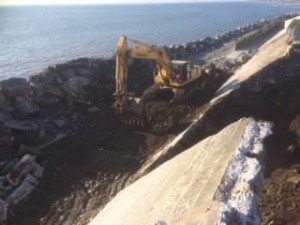Rail services between Barmouth to Harlech to be restored ahead of schedule

Trains are set to run again between Barmouth and Harlech on 1 May as Network Rail completes the massive £10m programme of storm repairs two weeks ahead of schedule.
Dozens of engineers have been working round the clock, seven days a week, to repair the sea defences and rebuild the railway line. One of the worst affected sites was at Llanaber, north of Barmouth, where the winter storms and tidal surges had severely damaged the infrastructure.
As part of the massive repair, 40 tonnes of debris have been removed and 6,000 pieces of ‘rock armour’ that form the sea protection have been replaced or repaired. In order to re-open the line, the team has also been replacing more than 1,000 sleepers, 2500 tonnes of ballast and 1400 metres of track.
Mark Langman, route managing director for Wales said: “I’m fully aware of the importance of the line to the local economy. We know it’s an important route for tourists and I’m determined that the work will be completed as soon as is possible. I’d also like to thank to local communities along the line for their patience whilst the work has been carried out”.
Lynne Milligan, Customer Services Director at Arriva Trains Wales adds “We welcome this good news and we would like to thank our customers for their patience and understanding over the last few months. We will continue to run a regular rail replacement bus service between Harlech and Pwlleli and look forward to the rest of the line reopening in the very near future.
ADVERTISEMENT
Beyond the repair work, a long-term strategy - the Coastal Asset Management Plan - is currently being developed to safeguard the 34 miles of Wales railway sea defences against the impact of extreme weather and changing climate. The long-term strategy builds on the existing annual £1.2m programme to maintain and renew the railway sea defences in Wales. It is also aimed at boosting resilience of the railway, using data based on increased frequency of severe weather and rising sea level predictions to inform the maintenance and renewal strategy for coastal routes.

